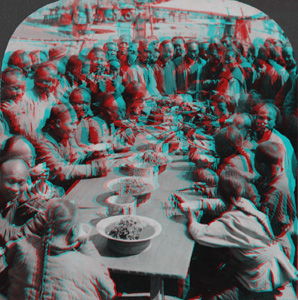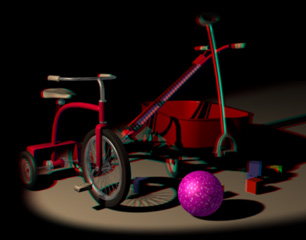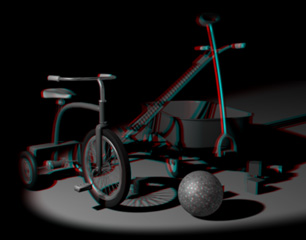Stereography with Lightwave 3D
page 3
Breaking the stereo window
You will recall our earlier discussion of the stereo window. If an object that is occluded by the edge of the window is stereoscopically in front of the window, we have set up conflicting depth cues. The brain tends to resolve this by flattening the area of conflict. (We saw this situation with the Humvee anaglyphs.) Antique stereocards are notorious for breaking the window, so we'll use a French Diablerie card as an example. Note the weirdly flickering bands on the edges of the leftmost stereo, below. Note how you see more on the right edge of the right image with your right eye. If you will look out a real window, you will see that the opposite should be the case: you should see more on the LEFT edge of the right image with your right eye.
We can fix this by pushing the stereo image back into the window, as in the example to the right. Unfortunately, we have to crop off some of picture. (This could be avoided with some reconstruction work in Photoshop...)
 |
 |
Breaking the window | A better alignment |
This century old scene from Peking has a pretty good window. Note while the man in the lower left (with his back to us) is still floating in front of the window, he is not disturbing to view. The top and bottom edges of the frame have no specific depth position, as they are horizontal. So this is a visually plausible condition. It is best if objects that fly off the screen exit to the top or bottom, without touching the sides.

While we're on the subject of stereocards, a device used to view a stereo image is called a "stereoscope." The most common type of viewer for these old cards, with the open top and sliding "t" bar holding the card, is a "Holmes Stereoscope," after its inventor, Oliver Wendell Holmes. A "stereopticon" is a type of magic lantern, with two lenses for quick slide changes or dissolves. The stereopticon really has nothing to do with three-dimensional imaging, don't embarass yourself by mis-using that term.
Various stereo displays.
Besides the anaglyph format we have been using in this document, stereo images can be recorded in many other ways. They may be kept as separate L/R files, they can be combined side-by-side or one on top of the other. They can be interlaced, with the Left image on one field and the Right on the other. It would be convenient if Lightwave had plug-ins to save to these various formats. And neat format for the web is JPS, stereo jpeg. The browser plug-in is currently available only for Windows platforms, but it allows the user to view the same stereo file in any of several forms: anaglyph, LCD shutters, or side-by-side. Recently, a Java applet has been made available that should run on all platforms without the use of a plug-in. (See the links section.)
The best way to show stereo on NTSC television is with interlaced stereo. Anaglyph barely works on broadcast quality NTSC, it doesn't work at all on VHS videotape. This is an inherent problem in the color space of NTSC. This may change with the advent of digital TV, but for now, don't plan on using anaglyph for television.
Terminology controversies
The whole process of aligning the left and right images for display has classically been called "convergence." However, I feel this is an ambiguous terminology that should be abandoned. In the first place, this usage has acheived only partial acceptance among practitioners in the field. More importantly, it tends to confuse the issues. In stereography, the images may be "converged" by toe-in of the cameras, by inset of the lenses, or by translation of the images in post-production (these techniques can also be applied during projection). But "convergence" is also used to describe the inward rotation of the eyes, and this, I think, tends to lead people to equate "convergence" with toe-in, and discount lens inset or image translation which, as I have demonstrated, are superior methods of "convergence." Because of the long history of this terminology, especially in stereoscopic cinema, it is difficult to avoid, but I suggest one use "alignment" or "setting the zero parallax plane" rather than "convergence." If the word "convergence" is unavoidable, try to make your specific meaning contextually clear.
Null object stereo cam
If you haven't upgraded to LW 5.6, or if you want to save the Left and Right images to separate directories, you can build a Null Object stereo camera. Create a Null Object at the origin. Name this "Camera Null." Parent the Camera to the Camera Null. Now, set up your scene by animating the null object. DO NOT KEYFRAME THE CAMERA (except at frame zero, where all settings should be at zero). Save the scene as "Center.lws". When ready to render, keyframe the camera at the zero frame with a negative X value. Set up a save path in the Render Panel. Save this as "Left.lws". Now, at the zero frame, keyframe the camera with a positive X value, change the save path and filename appropriately, and save as "Right.lws". Use ScreamerNet to set up a batch render of the two scenes.
Post-processing pair for stereo displays
Lightwave Plug-ins
Lightwave 5.6 includes two Image Filter Plug-Ins to work with the Stereoscopic Rendering option.
LW_AnaglyphStereoCompose replaces the red channel from the right image with the red channel from the left image. The left image is still saved to the directory with the "L" designation, while the anaglyph is saved with the "R" designation. This can be used with the Quicktime saver to make a movie, but is not compatible with the avi saver. This plug-in assumes use of a target to align the images. If one wishes to avoid toe-in, the anaglyph must be exported to an image processor that can translate the red channel to the proper zero parallax. This, of course, will probably also require cropping the image.
A problem with this is that it makes a color anaglyph, which is fine when it works, but because anaglyphs are viewed through colored filters, by definition the ability to transmit color is severly limited. In fact, the majority of scenes will flicker badly when combined as a color anaglyph. The only solution in such cases is to convert both the left and right to grayscale, then combine them as a monochromatic anaglyph. Currently, this can only be done outside LW.
Sometimes color anaglyph is inappropriate
 |
 |
Color anaglyph | Grayscale anaglyph |
LW_Anaglyph_Stereo_Simulate
My initial review of Stereo Simulate in this space was decidedly negative, but after discussing the plugin with the programmer, I have re-evaluated it. At first, I thought this image processing plugin merely shifted the red channel of the rendered image some amount (based on the "options" value), to push the entire image into the screen. (This plugin is intended to be used with Stereo Rendering OFF.) In the one scene I initially tried it, the Mustang scene I have used elsewhere, this appeared to be the case. However, what is actually happening is the plugin shifts pixels based on the value in the z-buffer (that is, the depth buffer). In some scenes, this will give some real 3D effect. This cannot be pushed very far, as the software has no idea what should be behind the shifted pixels--so it leaves a dupe of the shifted image in the original positions. If you examine the images closely, you can see this doppleganger even at the default value of 1.1. The doubling gets worse as you increase the value until eventually the image rips apart.
While on some images the effect is trivial, my initial recommendation to "avoid this plugin like the plague" was rash and overly harsh. The plugin has some experimental interest, but it is nowhere near the quality of a real stereoscopic camera render. Don't expect to use it professionally, but it has some amusement value.
See some examples of Stereo Simulate
If you need to do some custom processing of your anaglyphs, or if you need to set up for some other stereo format, you will need to go outside of Lightwave for post-processing. I can only touch upon the subject now; I will try to post up more details on these programs in the near future.
Adobe Photoshop and After Effects
Photoshop can be used to process stereo pairs into just about any format of stereo display. Unfortunately, even with the action features of v4, it's rather clumsy at processing sequences (I haven't got v5, so I can't comment on the improvements). For batching sequences, I prefer to use After Effects. For some TV res projects, Premiere is useful. If you need to set up for interlaced video, you might consider using an interlace mask in After Effects or Premiere to composite the left and right images. I have written a tutorial about making anaglyphs in Photoshop.
Stereo Image Factory
An excellent shareware program for Windows is the Stereo Image Factory. This program will import your left and right images, align them, crop them, and save them to about any form you might need. This is a great program for computer stereographers. Visit their web site at:
http://members.aol.com/threedr/Image FX
Those of you who still have your Amigas can use NovaDesign's Image FX to process your stereos. Image FX has terrific batch processing features. If you're making stereo for TV, I can highly recommend it. IFX's interlace feature will automatically put the pair together just as required--put one half in the front page and the other in the back and process. You can also use the deinterlace feature to tear apart an interlaced picture for further manipulation. It is also easy to set up a script to combine the images into either grayscale or color anaglyphs. For Toaster studios, this is the way to go.
Bibliography Links Previous Page Back to 3D Home